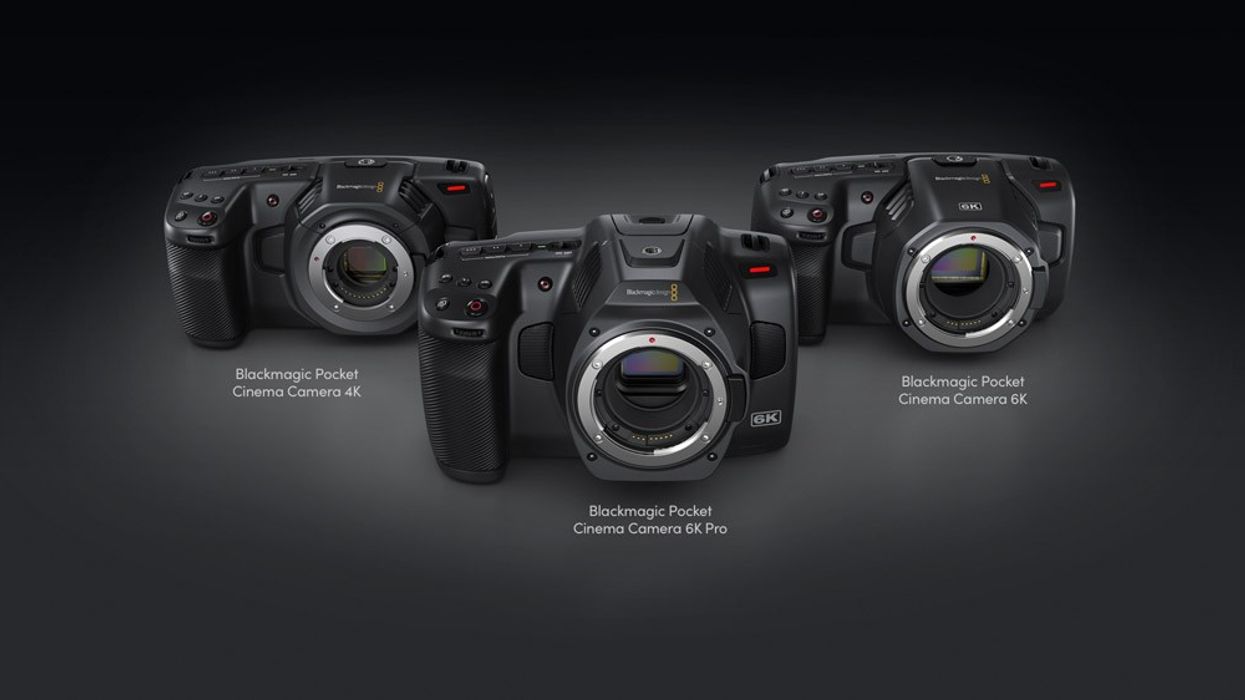Considering a Pocket Cinema Camera? The Lineup, Explained
Blackmagic offers a lot of cameras under the "Pocket" name, but which one is right for you?

Blackmagic first announced a camera with the name "Pocket" way back at NAB 2013, and at the time, it really was a camera that could fit in your pocket, with the right lens attached of course. A truly tiny little camera built around the MFT mount and shooting 2.5K, it was really amazing for its ability to shoot ProRes, and eventually even RAW, at 2.5K resolution in a camera that you could fit anywhere.
It was popular with independent filmmakers, of course, but also saw use on major films like the Spider-Man franchise, where it was used to mount to actors for creating POV shots while "flying through the air," since it was able to intercut so well with the bigger, more robust A camera.
In 2018, Blackmagic launched their newer Pocket lineup, which, while physically larger (the smallest one could fit in a larger park pocket, with the right lens), offered enough in image capture improvements to be worth the tradeoffs.
First off, the new units capture at least 4K, which is increasingly becoming the bare minimum in image capture. On top of that, they all work with timecode, meaning they are capable of timecode sync with each other to make multi-camera workflows a snap. Combine it with the automated timecode syncing in Resolve, and you have one of the fastest ways to both shoot and edit multi-camera footage all in a tidy little package.
The newer Pocket lineup also came along with the inclusion of Blackmagic Raw, the proprietary RAW capture format from Blackmagic (now fully supported in Final Cut Pro, Avid, Premiere, and Resolve) that allows for RAW image capture internally inside the camera.
While you could capture RAW in the original Pocket, it was Cinema DNG, which was a very heavy codec that ate up a lot of hard drive space and was slow to process in post. Blackmagic Raw eats up a lot less media space, while also being much easier on the editing side of the equation in post.
12K .BRAW files can even be edited on the smaller 13" Macbook Pro, which was impossible to imagine with even 2.5K Cinema DNG files.
The newer Pocket lineup also has taken full advantage of the possibilities of USB-C. The connector can be used to power the camera (on top of the separate 12V power input), charge the internal batteries, or shoot to external USB media. With the incredible prices of items like M.2 drives and Samsung T5 drives, shooting large RAW files all of the sudden became infinitely more affordable and available to independent and low-budget productions.
That's what the new lineup has in common, but what are the differences?
4K
Weighing in at only 1.5 lbs, the 4K Pocket remains an amazing choice for those shooters who need a truly lightweight camera body but want internal RAW capture. Built around the Micro 4/3 lens mount and sensor (often abbreviated MFT or M43), the 4K also can take advantage of the smaller, more affordable lens choices offered in that format. If you are looking for a RAW camera that truly could fit in a pocket (with a pancake lens, of which there are many wonderful choices in MFT), the 4K is the camera to consider.
Many wondered why, as Blackmagic has offered the 6K and the 6K Pro, it has kept the 4K in production, but between weight and lens mount options, there are still many compelling reasons why the 4K camera might be the right camera for an upcoming production.
6K
Bumping up to 1.98 lbs is the 6K, which also comes with a larger, roughly Super 35mm sensor size and an EF lens mount.
With hundreds of lenses available in the world in EF mount, you get a lot of variety, but they are going to be slightly pricier and larger than the MFT options, which makes the whole package an overall bigger investment in both size and cost than the truly tiny Pocket 4K.
6K Pro
Bumping up from the 6K you come to the 6K Pro at a still light 2.73 lbs, which has a few really compelling features vs. the 6K. You still have the EF mount, but the Super 35mm sensor now offers dual native ISO, with a separate 3200 ISO signal path that offers lower noise in low-light situations. On top of that, you get internal ND filters to make working outside easier. And most interesting, you have an optional viewfinder.
While the viewfinder doesn't seem that interesting to filmmakers at first, it comes with a tether cable that allows you to place it wherever you want with accessory arms. This means that you can mount it on an arm for a more traditional over-the-shoulder operating position, which many users will appreciate.
You get all that, and a tilting viewfinder to work with a variety of angles.
So there you have it. The newest Blackmagic Pocket camera can no longer fit in most pockets, but you can think of it as the camera that you can always have in your metaphorical pocket.
Because of the incredible price point, it puts RAW, high ISO shooting within the realm of possibility for a whole host of filmmakers who wouldn't have access otherwise. So you've got it in your pocket as a tool, even if it doesn't fit in your pocket the way the original did.

















